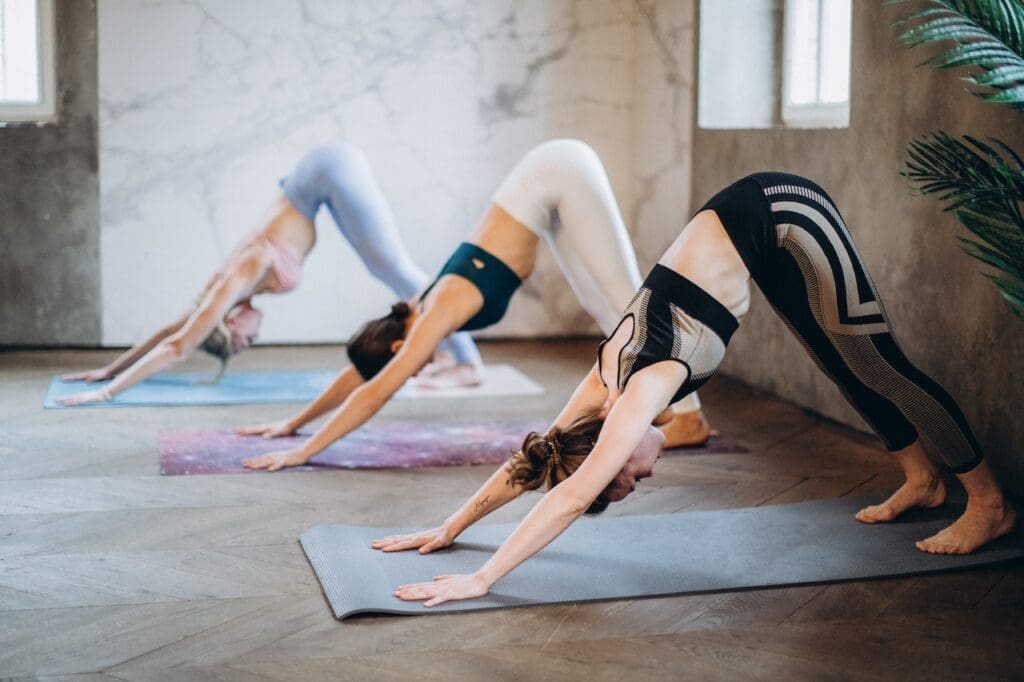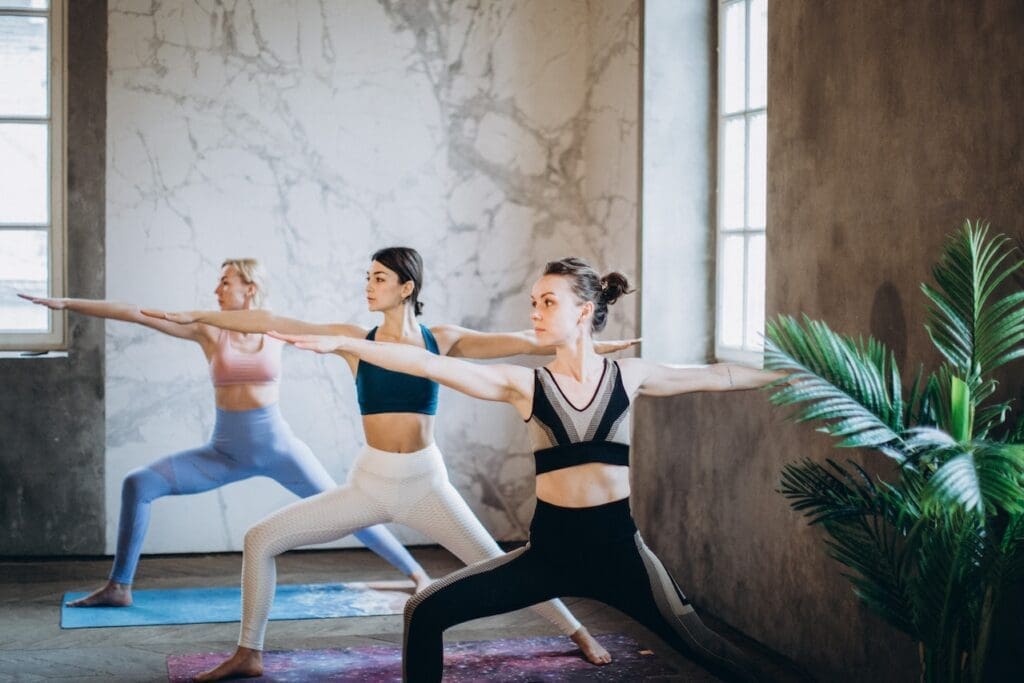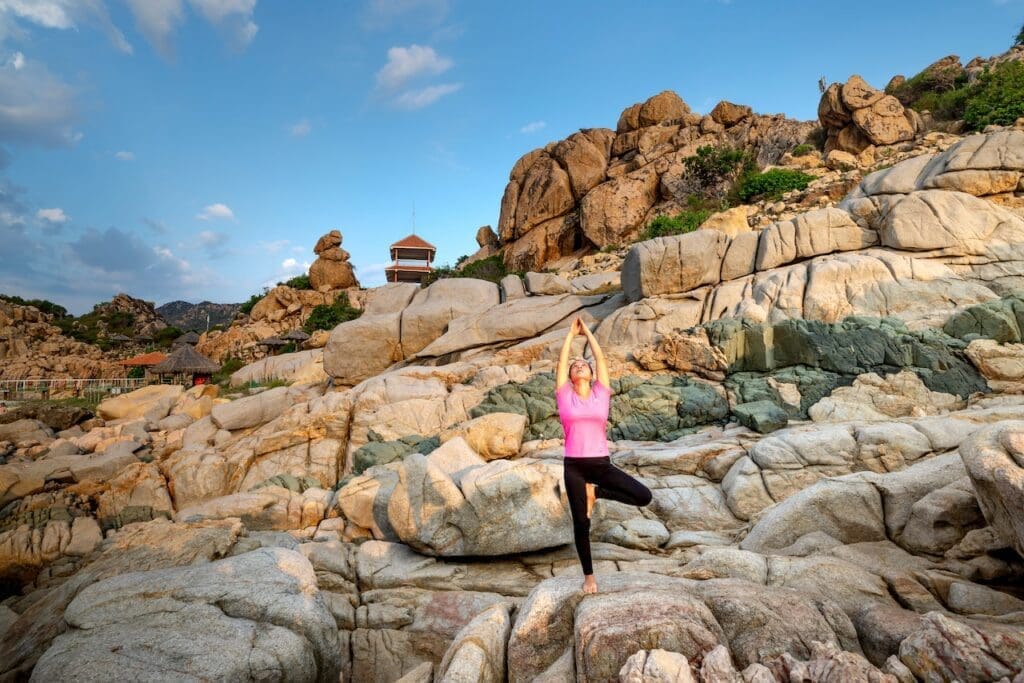Understanding Hatha Yoga: The Classical Style of Yoga
Welcome to the world of Hatha Yoga, a traditional form of yoga that’s been practiced for centuries. Derived from the Sanskrit words ‘Ha’ meaning ‘sun’ and ‘Tha’ meaning ‘moon’, Hatha Yoga is all about balancing opposing forces. The term ‘Hatha’ could also translate as ‘forceful’, indicating the physical effort involved in the traditional practices of Hatha Yoga.
In the vast world of yoga, Hatha stands as an umbrella term encompassing all styles of physical postures or ‘asanas’. Although modern yoga, with its multitude of styles, might seem overwhelming, Hatha Yoga serves as a serene and stable foundation. Here, yoga is not just about achieving the perfect posture; it’s about fostering a harmonious connection between the body, mind, and breath.
Hatha Yoga differs significantly from other types of yoga, such as Vinyasa. While both styles focus on asanas and have roots in the ancient text of Hatha Yoga Pradipika from the 15th century, their approach to yoga practice varies.
Hatha Yoga vs Vinyasa Yoga: Knowing the Difference
Defining Hatha and Vinyasa is crucial to understanding their differences. Hatha Yoga focuses on individual asanas held for extended periods, allowing the yogi to delve deep into each posture and breath. In contrast, Vinyasa Yoga, derived from Ashtanga Yoga, is a flowing style of yoga, where practitioners transition smoothly from one asana to another, synchronized with the breath, like a dance.
In a typical Hatha Yoga class, the emphasis is on mastering the alignment of each asana and on the vital energy (prana) guided through the body’s central channel. Conversely, a Vinyasa class is often more dynamic, focusing on the seamless sequence of yoga postures, making it feel like a moving meditation.
The choice between Hatha and Vinyasa (or any other style of yoga) largely depends on your personal preference and needs. If you crave a slower-paced class that provides ample time to explore each posture, Hatha Yoga might be your calling. Conversely, if you are looking for a fast-paced, rigorous workout that harmonizes movement with breath, you might find your heart in a Vinyasa Yoga class.
Hatha Yoga for Beginners: What to Expect in a Hatha Yoga Class
Embarking on a yoga journey can be thrilling yet intimidating, especially if you’re new to yoga. The good news is, Hatha Yoga is an excellent starting point for beginners.
In a Hatha class, you’ll explore the yoga postures at a leisurely pace, making it easier to learn and understand each asana’s intricacies. With a focus on basic postures, breath control (pranayama), and relaxation techniques, a Hatha Yoga class allows you to develop your flexibility, strength, balance, and breath awareness.
Traditional Practices of Hatha Yoga
The Role of Asanas in Hatha Yoga
In Hatha Yoga, asanas (postures) are more than just physical exercises. They are designed to improve the body’s physical health and clear the energy channels to facilitate the free flow of prana.
Asanas are integral to Hatha Yoga practice. While these physical poses can enhance flexibility and strength, their real value lies in the stillness they bring to the mind and body, paving the way for deeper spiritual practices. The Hatha Yoga Pradipika, a seminal guide, describes 84 asanas, with a focus on their spiritual benefits rather than physical prowess.
The next part of the content will cover the significance of pranayama and dhyana in Hatha Yoga, essential yoga poses for beginners, and numerous benefits of Hatha Yoga for novices. Stay tuned to know what to bring to your first yoga class, and how to sustain and grow your yoga journey.
The Importance of Pranayama in Hatha Yoga
In Hatha Yoga, equal importance is given to mastering Pranayama, the practice of breath control. Pranayama involves different breathing techniques aimed at regulating the flow of ‘prana’ or vital energy through the body. This practice not only improves lung capacity and respiratory function but also enhances focus, reduces stress, and aids in achieving a balanced state of mind.
Dhyana: The Practice of Meditation in Hatha Yoga
Dhyana, or meditation, is another fundamental aspect of Hatha Yoga. It involves focusing the mind on a single point of reference, like the breath or a mantra, to achieve a state of stillness and clarity. Regular meditation practice can lead to increased concentration, reduced anxiety, and a deeper sense of inner peace.
Essential Hatha Yoga Poses for Beginners
Hatha Yoga poses, known as asanas, are the building blocks of any yoga practice. For beginners, it’s crucial to start with basic poses to understand the correct alignment and breathing technique. Here are a few foundational Hatha Yoga poses:
1. Mountain Pose (Tadasana)

This is the foundational pose for all standing yoga asanas. To perform Tadasana, stand straight with your feet hip-width apart and balance your weight equally on both feet. Keep your spine erect, with your hands hanging alongside your body. Breathe in and out, feeling each breath move from your toes to the crown of your head.
Mountain Pose is an excellent asana for beginners as it helps improve posture, stability, and awareness. It’s a great way to start your yoga practice and tune into your body and breath.
2. Downward-Facing Dog (Adho Mukha Svanasana)

This is a classic yoga pose that strengthens and stretches the entire body. To perform this pose, start on your hands and knees. Press your hands into the floor and lift your hips, straightening your legs to form an inverted ‘V’. Engage your core, press your heels towards the floor, and keep your head between your arms.
Downward-facing dog enhances upper body strength, promotes blood flow to the brain, and helps to calm the mind. For beginners, it’s an excellent pose to transition between asanas.
3. Warrior Poses (Virabhadrasana I, II, III)

The Warrior Poses are powerful asanas that build lower body strength and stamina. These poses also open up the chest and hips, improving breathing and posture. They require focus and determination, embodying the spirit of a warrior.
- Warrior I: Stand in Mountain Pose, step your right foot forward and bend the right knee. Keep the left foot planted at a 45-degree angle. Raise your arms overhead, palms facing each other. Repeat on the other side.
- Warrior II: From Warrior I, open your hips and torso to the side and extend your arms parallel to the floor, gazing over your right hand. Repeat on the other side.
- Warrior III: From Mountain Pose, lean forward and lift your left leg off the floor, balancing on the right leg. Extend your arms forward and keep your body and lifted leg parallel to the floor. Repeat on the other side.
4. Tree Pose (Vrksasana)

Tree Pose is a balancing asana that promotes focus and calm. Stand straight, bend your right knee and place the right foot high on your left thigh. Once balanced, bring your hands together in a prayer position at your chest. If comfortable, extend your arms above your head.
Tree pose improves balance, enhances concentration, and strengthens the legs and core. It’s a peaceful yet challenging pose for beginners, representing growth and balance in your yoga practice.
The Benefits of Hatha Yoga: Why Hatha is Great for Beginners
Hatha Yoga offers countless benefits, making it an ideal choice for beginners. Here’s why:
Physical Benefits
Hatha Yoga’s slow pace and focus on individual poses make it a great workout for the body. It’s a low-impact exercise that can improve flexibility, build muscle strength, enhance balance, and increase stamina. Hatha Yoga also promotes better breathing through pranayama techniques, which can improve lung capacity and respiratory health.
The practice of asanas increases blood flow, enhances the immune system, and promotes healthier organs. Furthermore, Hatha Yoga can provide relief from chronic conditions like lower back pain, arthritis, and insomnia.
Mental and Emotional Benefits
Aside from the physical benefits, Hatha Yoga has profound effects on mental and emotional health. The concentration required to hold asanas can help clear the mind and reduce stress, promoting mental calmness and relaxation. This focus on mindfulness can improve concentration and cognitive function.
Meditation (Dhyana) and breath control (Pranayama) are key aspects of Hatha Yoga. They foster self-awareness and mental clarity, helping to manage anxiety and depression. Over time, this can lead to a deeper understanding of oneself and foster an overall sense of well-being.
Tips for Your First Hatha Yoga Class
Starting something new can be intimidating, but with the right preparation, your first yoga class doesn’t have to be. Here are some tips to help you prepare:
- What to Bring: Typically, you’ll need a yoga mat, comfortable clothing, a towel, and a water bottle. Some studios provide mats, but it’s always good to call ahead and check.
- Setting Expectations: Everyone’s yoga journey is unique. Remember, it’s not about doing the poses perfectly; it’s about connecting with your body and breath.
- After Class: Regular practice is essential for growth. Aim to attend yoga classes regularly and supplement studio sessions with home practice.
By following these tips, you can ensure a smooth transition into your yoga journey.
In the Path of Hatha Yogis: How to Incorporate Hatha Yoga in Your Daily Routine
Establishing a regular Hatha Yoga practice can seem daunting initially, but consistency is key. Start with just a few minutes each day, gradually increasing your practice time. You could also attend a Hatha Yoga class a few times a week to maintain regularity.
Hatha Yoga: Not Just a Physical Practice
Hatha Yoga is more than just a physical workout. It’s a holistic practice that integrates physical postures, breath control, and meditation to cultivate physical health, mental clarity, and spiritual growth.
Conclusion: Embracing Hatha Yoga
If you’re new to yoga, Hatha Yoga is a fantastic place to start. With its focus on individual postures and slow, mindful movements, it provides a thorough understanding of yoga basics. So, roll out your mat and embark on your yoga journey. Remember, it’s your journey, and every step, every breath, every moment on the mat counts.
Embrace the holistic experience that Hatha Yoga offers and uncover the potential for transformation within you. Discover the yogi in you today!
Related content –
How to Integrate Yoga into Your Daily Routine: 10 Practical Tips and Techniques
10 Remarkable Health Benefits of Yoga Supported by Science
Surya Namaskar for Beginners: An Easy-to-Follow Guide to master 12 poses of SUN Salutation
FAQs
Q: How is Hatha yoga different from regular yoga?
A: Hatha yoga is a style of yoga that primarily focuses on physical postures (asanas) and breath control (pranayama). Regular yoga is an umbrella term that can refer to any style of yoga. Hatha yoga is considered a gentle and slower-paced practice, making it a great choice for beginners.
Q: Is Hatha yoga hard for beginners?
A: Hatha yoga is actually ideal for beginners. It’s a style that’s slow-paced, allowing you to understand and get comfortable with each pose. Additionally, Hatha yoga incorporates a lot of basic poses that are suitable for beginners.
Q: What is Hatha yoga?
A: Hatha yoga is a traditional style of yoga that includes the practice of asanas (physical postures) and pranayama (breathing exercises). These two elements are often paired with meditation to cultivate a well-rounded yoga practice.
Q: What is easier, Hatha or Vinyasa?
A: Typically, Hatha yoga is considered easier than Vinyasa. Hatha yoga is slower-paced and focuses on holding poses for longer periods, making it more suitable for beginners or for those who prefer a more meditative, relaxed practice. Vinyasa, on the other hand, involves more complex sequences and a faster pace, often requiring a higher level of physical fitness.
Q: What is special about Hatha yoga?
A: What’s special about Hatha yoga is its focus on balance. The word “Hatha” itself means “sun” (ha) and “moon” (tha), symbolizing the balance of opposites. This style of yoga aims to balance mind and body through asanas, breathing exercises, and meditation. It’s a holistic practice that addresses physical health, mental clarity, and spiritual growth.
Q: How do I start Hatha yoga for beginners?
A: Starting Hatha yoga for beginners involves finding a comfortable space, wearing suitable attire, and beginning with basic poses. It’s beneficial to join a beginner-friendly Hatha yoga class or to follow guided sessions online. Remember to take it slow, respect your body’s limits, and focus on your breath.




















